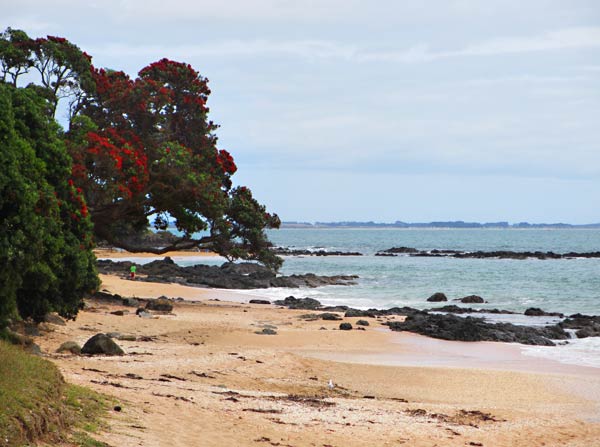December 2013
By choosing the Bay of Islands as our “home base” in New Zealand, we could see a lot of Northland (New Zealand north of Auckland) in a series of day trips by car. For now, we were concentrating on what they call the Far North, the area that stretches from Whangaroa (see previous New Zealand blog) to the top of the island.
Being from America, I can’t help but associate “far north” with cold temperatures, vast wilderness, pine forests and pounding surf. In New Zealand, the “far north” is also associated with wilderness, but this wilderness consists of beautiful calm bays, miles and miles of white sand beaches, grassy sand dunes, pohutukawa trees, and warm temperatures.
Having done Whangaroa, our next destination to explore would be just north of that: Doubtless Bay and the Karikari Peninsula.
The Karikari Peninsula sticks out of New Zealand like a big upside-down boot. A land mass a few miles below it also juts out, and together they form the borders of Doubtless Bay. Doubtless Bay’s most prominent feature its long stretches of beach. And because its remote location, these beaches remain uncrowded even at the peak of the holiday season. If you don’t like one beach, you can just move to another! (This is true for much of the north island, but for now I’m focusing on the beaches of Doubtless Bay).

Doubtless Bay is just around a corner from Mangonui (of fish and chips fame), so it would be very convenient to grab a bite there before exploring this area. But having planned to visit the a winery/restaurant at the end of the Karikari Peninsula, we passed on the fish and chips.
Our first stop was beautiful Coopers Beach, where pohutukawa trees line a long stretch of sand. Unfortunately a combination of cloudy skies, high tide, and fading pohutukawa blossoms did not make for very good pictures. We’ll try to get back next year on a sunny day, earlier in the season.




Next up was Cable Bay, famous for its pinkish sand and rock pools. Those black rock outcrops in the light sand reminded me of the beaches in western Samoa.




Next, we continued through the town of Taipa before turning right and heading up the Karikari peninsula, which has a more remote, windswept feeling. We headed to the shore to see Tokerau Beach which runs the entire length of the peninsula.




Finally, we headed to Maitai Bay up by the toe of the boot. It was a long way out there on the main road, and then a few miles on unpaved road. The first thing we discovered: this is a popular place for campers! Camping is a very popular pastime in the summer, and this was a prime destination. Parking was difficult and we ended up driving through a sea of campsites, unable to find room to even turn around! Finally we came out to a clearing, which just so happened to be above the bay and had room enough to park the car. We made our way to the beach, and it was stunning: calm blue-green water was striking against a perfect crescent of white sand beach. Strangely, very few people were there—they all seemed to prefer to stay at their campsites.



After taking this in, we went to the other bight of Maitai Bay, separated from this one by a small peninsula. This bay was larger, but just as beautiful and perfect—and empty. Go figure. At one end was a huge pohutukawa tree covered with red blossoms, and if you walk through the low-lying canopy you come out to a beautiful little beach on the other side, a white crescent of sand with green water. This was truly a magical place, and worth the long drive on unpaved road and through a sea of campsites to see it. Our next quest: wine and lunch at the nearby winery. –Cyndi










